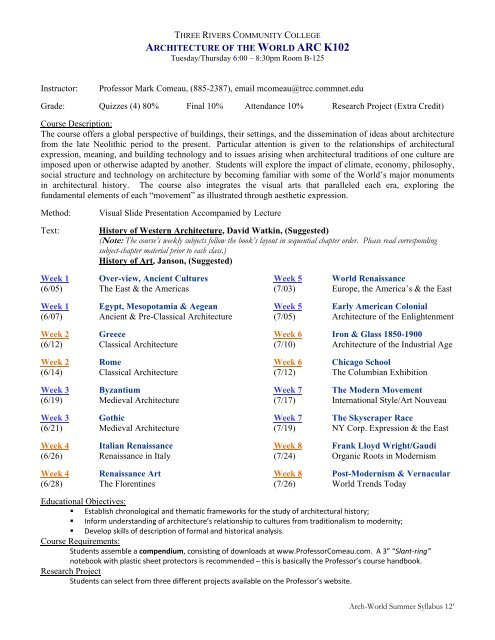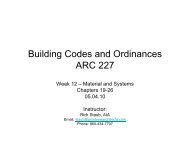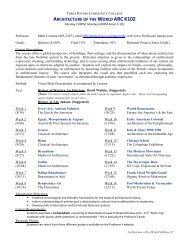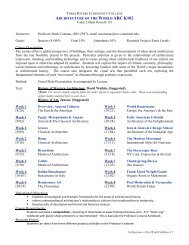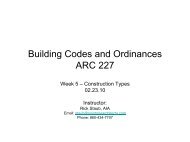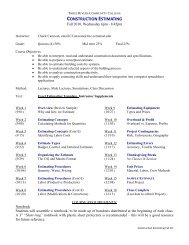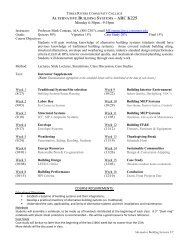ARCHITECTURE OF THE WORLD ARC K102 Instructor: Professor ...
ARCHITECTURE OF THE WORLD ARC K102 Instructor: Professor ...
ARCHITECTURE OF THE WORLD ARC K102 Instructor: Professor ...
Create successful ePaper yourself
Turn your PDF publications into a flip-book with our unique Google optimized e-Paper software.
THREE RIVERS COMMUNITY COLLEGE<br />
<strong><strong>ARC</strong>HITECTURE</strong> <strong>OF</strong> <strong>THE</strong> <strong>WORLD</strong> <strong>ARC</strong> <strong>K102</strong><br />
Tuesday/Thursday 6:00 – 8:30pm Room B-125<br />
<strong>Instructor</strong>:<br />
<strong>Professor</strong> Mark Comeau, (885-2387), email mcomeau@trcc.commnet.edu<br />
Grade: Quizzes (4) 80% Final 10% Attendance 10% Research Project (Extra Credit)<br />
Course Description:<br />
The course offers a global perspective of buildings, their settings, and the dissemination of ideas about architecture<br />
from the late Neolithic period to the present. Particular attention is given to the relationships of architectural<br />
expression, meaning, and building technology and to issues arising when architectural traditions of one culture are<br />
imposed upon or otherwise adapted by another. Students will explore the impact of climate, economy, philosophy,<br />
social structure and technology on architecture by becoming familiar with some of the World’s major monuments<br />
in architectural history. The course also integrates the visual arts that paralleled each era, exploring the<br />
fundamental elements of each “movement” as illustrated through aesthetic expression.<br />
Method:<br />
Text:<br />
Visual Slide Presentation Accompanied by Lecture<br />
History of Western Architecture, David Watkin, (Suggested)<br />
(Note: The course’s weekly subjects follow the book’s layout in sequential chapter order. Please read corresponding<br />
subject-chapter material prior to each class.)<br />
History of Art, Janson, (Suggested)<br />
Week 1 Over-view, Ancient Cultures Week 5 World Renaissance<br />
(6/05) The East & the Americas (7/03) Europe, the America’s & the East<br />
Week 1 Egypt, Mesopotamia & Aegean Week 5 Early American Colonial<br />
(6/07) Ancient & Pre-Classical Architecture (7/05) Architecture of the Enlightenment<br />
Week 2 Greece Week 6 Iron & Glass 1850-1900<br />
(6/12) Classical Architecture (7/10) Architecture of the Industrial Age<br />
Week 2 Rome Week 6 Chicago School<br />
(6/14) Classical Architecture (7/12) The Columbian Exhibition<br />
Week 3 Byzantium Week 7 The Modern Movement<br />
(6/19) Medieval Architecture (7/17) International Style/Art Nouveau<br />
Week 3 Gothic Week 7 The Skyscraper Race<br />
(6/21) Medieval Architecture (7/19) NY Corp. Expression & the East<br />
Week 4 Italian Renaissance Week 8 Frank Lloyd Wright/Gaudi<br />
(6/26) Renaissance in Italy (7/24) Organic Roots in Modernism<br />
Week 4 Renaissance Art Week 8 Post-Modernism & Vernacular<br />
(6/28) The Florentines (7/26) World Trends Today<br />
Educational Objectives:<br />
• Establish chronological and thematic frameworks for the study of architectural history;<br />
• Inform understanding of architecture’s relationship to cultures from traditionalism to modernity;<br />
• Develop skills of description of formal and historical analysis.<br />
Course Requirements:<br />
Students assemble a compendium, consisting of downloads at www.<strong>Professor</strong>Comeau.com. A 3” “Slant‐ring”<br />
notebook with plastic sheet protectors is recommended – this is basically the <strong>Professor</strong>’s course handbook.<br />
Research Project<br />
Students can select from three different projects available on the <strong>Professor</strong>’s website.<br />
Arch-World Summer Syllabus 12’
EXPANDED COURSE OVERVIEW<br />
Architecture of the World is an informative and intense course. Considerable content will be<br />
conveyed to the student while building a logical basis for understanding the design<br />
philosophies and conditions which shaped architecture from pre-history to the present.<br />
The course is divided into (four) 4 week sections:<br />
The first section examines the origins of ancient-world architecture with specific focus on the<br />
cultures of Egypt, Mesopotamia and the Aegean. Differences in climate, geography, materials,<br />
philosophy, social structure and technology will be explored to discover how these are<br />
reflected in the architecture of each culture.<br />
This section will also explore the classical architecture of Ancient Greece and Rome, as<br />
students are introduced to: the principles of the Architectural Orders and the elements of<br />
which they are composed; detailing; engineering advances; proportion, and planning theories.<br />
Christian Architecture will be traced from its origins in Rome through the synthesis of form,<br />
function, philosophy and structure in the Gothic Cathedrals.<br />
The second section examines the origins of the Renaissance in Italy and the development of<br />
the various Renaissance styles from Early Renaissance through the Baroque Period. The<br />
economic, political, social and technical influences which shaped this movement will be<br />
explored to provide a better understanding of the meaning of the forms used.<br />
This section will also explore the spread of Renaissance ideas and designs throughout Europe,<br />
the Americas and the East. Particular attention will be placed on the development of<br />
Renaissance design in France and England.<br />
The development of architecture in America will be traced from the Colonial Period through<br />
the Gothic Revival. Students will explore the relationship of American architecture to cultural<br />
developments in Europe as well as the search for an appropriate American style.<br />
The third section examines how society in general and architecture in particular, reacted to the<br />
changes and technology brought about by the Industrial Revolution. Students will explore<br />
initial reactions as they found their expressions in architecture, a period covering the years<br />
roughly between 1850c and 1900c.<br />
This section will also examine the period covering 1900c to World War I as architectural<br />
response was refined in a search to express the new century. The period covering World War<br />
I to World War II is the final portion of this section to be explored as students discover how<br />
the war graphically demonstrated the immense power of technology for both construction and<br />
destruction, thus, causing a general reassessment of values in society, architecture and design.<br />
The fourth and final section examines the period from World War II to the present day.<br />
Students will discover how America emerged as a World power and leader in technology and<br />
architectural expression. Architectural periods covered which illustrate this include those such<br />
as the race of the skyscraper, the Modern Movement, the Chicago School, the Shingle Style,<br />
Post Modernism and more. This section will also explore the current period of architecture in<br />
practice today as well as provoke discussions concerning the civic and social responsibilities of<br />
architecture of the past and how it may influence that of the future.<br />
Arch-World Summer Syllabus 12’
ACADEMIC PERFORMANCE<br />
Lecture Period:<br />
Students shall respect the classroom environment. <strong>Professor</strong>s invest valuable time in lecture preparation to<br />
make the course content organized, interesting, and understandable and to make the learning environment<br />
collegial. Unless specifically directed by the professor, students shall refrain from sending email and instant<br />
messages, or from engaging in other activities (reading non-course materials, engaging in private<br />
conversations and so on), that disrespect the classroom environment and learning conditions for others.<br />
Access to the Internet can be a valuable aid to the classroom learning environment. Students are encouraged<br />
to use laptops, smart phones, and other devices in order to explore concepts related to course discussions and<br />
topics. Students are discouraged from using technology in ways that distract from the learning community<br />
(e.g. Facebook, texting, work for other classes, etc.) and if found doing so, will be asked to leave the<br />
classroom for the day and will not get credit for attendance that class period.<br />
Assessment:<br />
Assessment of your mastery of the Courses learning objectives is administered through quizzes, exams, and<br />
essays. These are announced with ample preparation time and sometimes a study guide. Upon absence from<br />
a class in which an assessment is given, it is the student’s responsibility to request, coordinate and schedule, a<br />
makeup date and time with the professor. Assessments not made up within one week from when initially<br />
given will result a three point reduction from the score earned, per class period lapse.<br />
Integrity:<br />
Any and all exams, papers or reports submitted by you and that bears your name is presumed to be your own<br />
original work that has not previously been submitted for credit in another course unless you obtain prior<br />
written approval to do so from your professor.<br />
In all of your assignments, including homework or drafts of papers, you may use words or ideas written by<br />
other individuals in publications, web sites, or other sources but only with proper attribution. "Proper<br />
attribution" means that you have fully identified the original source and extent of your use of the words or<br />
ideas of others that you reproduce in your work for this course, usually in the form of a footnote or<br />
parenthesis.<br />
As a general rule, if you are citing from a published source or from a web site and the quotation is short (up<br />
to a sentence or two), place it in quotation marks; if you employ a longer passage from a publication or web<br />
site, please indent it and use single spacing. In both cases, be sure to cite the original source in a footnote or<br />
in parentheses. (See http://www.plagiarism.org/plag_article_how_do_I_cite_sources.html for more<br />
information on citing.)<br />
If you are uncertain about the expectations for completing an assignment or taking a test or examination, be<br />
sure to seek clarification from your professor beforehand.<br />
Finally, you should keep in mind that as a member of the Three Rivers Community College community, you<br />
are expected to demonstrate integrity in all of your academic endeavors and will be evaluated on your own<br />
merits.<br />
Be proud of your academic accomplishments and help to protect and promote academic integrity. The<br />
consequences of cheating and academic dishonesty may include a formal discipline file, possible loss of<br />
financial scholarship or employment opportunities, and denial of admission to a four year college.<br />
Arch-World Summer Syllabus 12’


